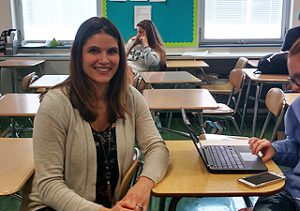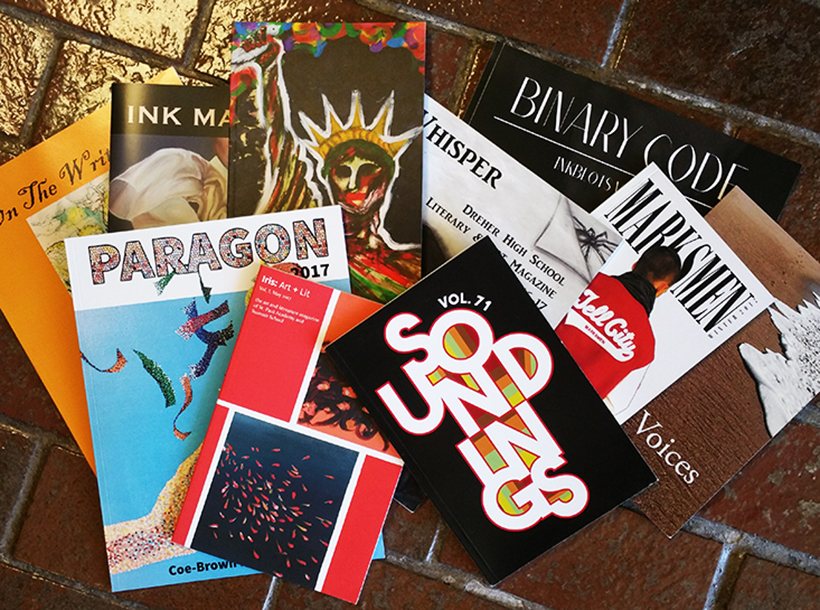This post was written by Lee Ann van der Kwast.
I have spent several years as the faculty advisor for our high school creative arts magazine, Element. My main takeaway? As a result of all of the time, energy, and hard work in situating this collective work in the school setting and beyond the school community, our student writers have experienced being real authors with authentic audiences.
As an extra-curricular activity, student publications such as literary magazines become supplemental learning opportunities for students to practice and engage in their writing craft. A student editor and contributor expressed this in an end-of-the-year survey:
“Prior to submitting my work I wasn’t very confident in how it looked and how creative it was, but after, I realized I need to give myself more credit. Just because it’s not a masterpiece doesn’t mean it’s not good. The publication gave me more confidence in my work.”
Students take the rigorous writing instructions from the classroom curriculum, practice and invest their effort and time into sharpening their writing skills, and intermix the creative process with the writing process. When they submit to Element, they have a heightened awareness that people will read their work, so there is a sense of ownership and pride that goes into the writing process.
Furthermore, the students involved in the production process are also exploring and practicing for college and the work force—life after high school.
A student editor and contributor said this,
“In the publication process I helped in all aspects. I helped with editing the pieces, formatting, and putting them onto the page. It showed me there is so much more work than expected when producing something like this. It helped me with time management and makes me appreciate the product more. Now I know how much dedication it takes.”
By collaborating on ideas, working with committees, setting goals/meeting deadlines, problem solving, marketing, advertising, fundraising, keeping records, use of technology, and so on, student publications offer important life skills.
In addition, the production experience gives students exposure to and skills in other fields of study and careers, such as editing, publishing, writing, teaching, graphic design, business/marketing, etc.
For the student contributors and student production members, student publications provide not only a creative outlet for students, but opportunities to build on skills introduced in the classroom. One student editor and contributor reflected on her experience with the student publication this way:
“I’ve become more aware all of the aspects of my art. Now I notice all the little details and see how they matter more than before. I take more time on my art and don’t rush to get it over with. I see now that something can become of it and it’s worth the extra time to perfect it.”
I intend to continue to encourage students to publish their writing, not just in the school’s creative arts magazine but also through digital publication sites, by setting up an approved list of reliable online publication opportunities on my website.
Students can be authors in every sense of the word, and it’s important to use student publications as a means of helping student writers see this for themselves, and realize both their place on the publishing spectrum and the wide array of readers they can reach through school, community, and Internet venues.
Among the benefits, it’s obvious that student publications help student contributors and editors in their writing and creative processes, and this can only enhance a curriculum’s already rigorous academic writing instruction in preparing students for life and careers after high school.
Student publications bridge a gap between creative and academic writing in the curriculum, and given the many venues in which student publications are available to be shared—classrooms, school and local libraries, home coffee tables and business waiting rooms, plus the myriad electronic means—the potential readership is virtually limitless.
Best of all, student-produced creative arts publications lead to young writers who are invested and confident, and ready to write for real audiences outside of the classroom.

Lee Ann van der Kwast is a ninth-grade English and creative writing teacher at Methacton High School in Eagleville, Pennsylvania. She has been a club adviser for the creative arts magazine for four years. “Creative writing,” she says, “is more than a skill to teach, so as an educator, it’s important to give students a creative space to express themselves.”
Do you work with a student literacy magazine? The REALM program publicly recognizes excellent literary magazines produced by students with the support of their teachers. The application is now live for the 2022 program. Entries will be accepted up to July 31. Read more and apply today.
It is the policy of NCTE in all publications, including the Literacy & NCTE blog, to provide a forum for the open discussion of ideas concerning the content and the teaching of English and the language arts. Publicity accorded to any particular point of view does not imply endorsement by the Executive Committee, the Board of Directors, the staff, or the membership at large, except in announcements of policy, where such endorsement is clearly specified.

